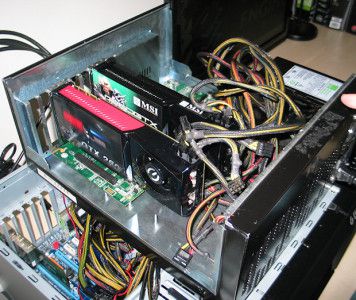From our front-page news:
If there's one product that both AMD and NVIDIA would share an opinion on, it's Lucid's Hydra. This is a chip that's set out to essentially replace CrossFireX and SLI, if all goes according to plan. Rather than handle multiple GPUs with alternate-frame rendering, Lucid's Hydra shares the load in a way that the company won't reveal - probably for good reason. The question, of course, is whether the company's technology is worthy of belonging in any of our machines. Is it?
Well, it's far too early to answer that, of course, as the product isn't officially released, but our friends at The Tech Report have taken a trip down to Lucid's HQs to give the product a test in its lab. Benchmarking this way is never ideal, for obvious reasons, but it's better than nothing. After his exhaustive look within the time constraints, Scott was left impressed in some regards, but not entirely wowed in others. There's more work to be done before the product's final launch, it goes without saying.
In its current form, the scaling works well in some cases, but not well in others. For example, in F.E.A.R. 2, a single HD 4890 card proved faster than an HD 4890 + HD 4770, which makes no sense, as more power should equal more performance. This could be due to improper load balancing between a fast and slower card, but I'm hoping to see Lucid iron out this particular issue before the first iteration gets released. Not all combos suffer like this, however, as a GTX 260 + HD 4890 combination hit almost 25% more performance over a single GTX 260 (but it should be more like 50% at least).
Despite the issues, this technology has a ton of potential, and it's rather incredible to see what this small company has pulled off thus far. It's already received a bit of funding, and even Intel seems to be backing it, so with a little more time, and perhaps a little more money, Lucid could become a real competitor to CrossFireX and SLI. And who knows... it may even render those useless. For the time-being, though, and based off of the initial performance, neither AMD or NVIDIA has much to stress over.

To execute Lucid's load-balancing algorithms, the Hyrda chip also includes a 300MHz RISC core based on the Tensilica Diamond architecture, complete with 64K of instruction memory and 32K of data memory, both on-chip. The chip itself is manufactured by TSMC on a 65-nm fabrication process, and Lucid rates its power draw (presumably peak) at a relatively modest 6W.
Source: The Tech Report
Well, it's far too early to answer that, of course, as the product isn't officially released, but our friends at The Tech Report have taken a trip down to Lucid's HQs to give the product a test in its lab. Benchmarking this way is never ideal, for obvious reasons, but it's better than nothing. After his exhaustive look within the time constraints, Scott was left impressed in some regards, but not entirely wowed in others. There's more work to be done before the product's final launch, it goes without saying.
In its current form, the scaling works well in some cases, but not well in others. For example, in F.E.A.R. 2, a single HD 4890 card proved faster than an HD 4890 + HD 4770, which makes no sense, as more power should equal more performance. This could be due to improper load balancing between a fast and slower card, but I'm hoping to see Lucid iron out this particular issue before the first iteration gets released. Not all combos suffer like this, however, as a GTX 260 + HD 4890 combination hit almost 25% more performance over a single GTX 260 (but it should be more like 50% at least).
Despite the issues, this technology has a ton of potential, and it's rather incredible to see what this small company has pulled off thus far. It's already received a bit of funding, and even Intel seems to be backing it, so with a little more time, and perhaps a little more money, Lucid could become a real competitor to CrossFireX and SLI. And who knows... it may even render those useless. For the time-being, though, and based off of the initial performance, neither AMD or NVIDIA has much to stress over.

To execute Lucid's load-balancing algorithms, the Hyrda chip also includes a 300MHz RISC core based on the Tensilica Diamond architecture, complete with 64K of instruction memory and 32K of data memory, both on-chip. The chip itself is manufactured by TSMC on a 65-nm fabrication process, and Lucid rates its power draw (presumably peak) at a relatively modest 6W.
Source: The Tech Report
